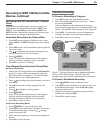
80 Chapter 7. Using IEEE 1394 Devices
Overview
Compatible IEEE 1394 Devices
Compatible A/V devices include some, but not all, cable
boxes, D-VHS VCRs, A/V discs, and future products.
Some devices may have IEEE 1394 connectors but are not
compatible with the TV. Areas of compatibility to consider
are:
1. Digital Video Signals
The TV can decode MPEG2 video as provided by cable
boxes and some camcorders. Many camcorders provide
DV video, which the TV cannot decode. Connect a DV
camcorder to the TV using analog audio plus composite
video, S-video, or component video, or use HDMI audio/
video. Other types of digital video, such as PC video
provided by some computers, must be decoded by the
source device and sent to the TV as analog video, S-video,
or DVI/HDMI video.
2. Digital Audio Signals
When received with video signals, the TV can decode
Dolby Digital signals and MPEG audio signals. Other
types of digital audio as provided by some digital record-
ing devices, such as MP3 audio and DTS audio, cannot be
decoded by the TV when received over IEEE 1394 con-
nections.
The TV may not be able to pass incompatible digital audio
signals on the coaxial digital audio output. These signals
may pass to other devices, however, on the IEEE 1394 cable.
3. Digital Control Signal
The TV can serve as the control center for IEEE 1394
audio/video devices, such as VCRs, A/V Discs, tuners,
cable boxes, and amplifiers that are compatible with the
following IEEE 1394 control standards.
• EIA-775. Designed for tuning devices such as cable
boxes, allowing the device to send simple graph-
ics. This standard does not, however, allow the TV to
control the cable box by IEEE 1394.
• AV/C (Audio Video Control). Designed to provide
basic controls such as play, stop, channel selection,
and volume, as appropriate for the device.
Four-Pin and 6-Pin Connections
There are two different types of connectors used for IEEE
1394 terminals and cables: a 4-pin and a 6-pin type.
Both types send the same digital audio, video, and control
signals, but the 6-pin connectors can also supply low-
voltage electrical power to connected devices. This TV
uses only 4-pin type connectors.
A
6-pin connector cannot be connected directly to a 4-pin
jack, and vice versa. To connect a 6-pin device to a 4-pin
device, use a 6-pin-to-4-pin adapter or adapter cable. These
cables are available from electronics and computer stores.
4-pin connector 6-pin connector
6-pin-to-4-pin adapter
If you wish to connect a 6-pin device to the TV (such as a
camcorder), and the device is designed to receive electri-
cal power from another 6-pin device, there are several
ways to provide electrical power to the device:
• Connect the camcorder directly to the household AC.
• Use the camcorder’s battery for power.
• Connect the camcorder directly to another 6-pin
device in the network that can provide power.
Connection Methods
There are two connection methods for IEEE 1394 devices. Use
the method that fits your network of audio/video products.
Direct Device-To-Device Method
The IEEE 1394 interface allows you to chain devices,
unlike audio and video connections that require you to
connect each individual device directly to the TV. For
example, you can connect your D-VHS to your 1394 A/V
disc and then connect the 1394 A/V disc to the TV. The
resulting IEEE 1394 chain allows you to add more devices
to the chain. You will see an icon for each device in the
TV’s Input Selection menu and can also send information
from any IEEE 1394 device to other compatible devices.
Hub Connection Method
The IEEE 1394 standard allows you to use the TV as a hub
within the audio/video network. Each device can send
information, which may include audio and video, to any
other device in the network.


















